Experimental Study on Overlay Tester of Asphalt Mixture Based on Discrete Element Method
Abstract
1. Introduction
2. Development of a Virtual Model Based on the DEM
2.1. Aggregate Gradation and Classification Assumptions
2.2. The Proportion of Coarse Aggregate Volume
2.3. Monotonic Tensile OT Test
2.4. Development of the OT Numerical Model
2.4.1. Generation of the OT Specimen
2.4.2. Definition of the Contact Model
2.4.3. Definition of Loading Conditions
3. Results and Discussion
3.1. The Influence of Different Thicknesses on the OT Test
3.2. Fractal Characteristics of Cracks in the OT Test
3.3. Force Chain Characteristics in the OT Test
3.4. Contact Force Characteristics of the OT Test
3.5. Analysis of Aggregate Displacement Characteristics
4. Conclusions
- (1)
- Under three different sample sizes of 52 mm × 104 mm, 78 mm × 156 mm, and 104 mm × 208 mm, SMA13 exhibits a superior skeleton structure and an enhanced load-bearing capacity compared to AC13. In thinner samples, the distribution of coarse aggregate is notably non-uniform. As the sample thickness increases, the peak load of AC13, SMA13, and LSPM30 all show a decreasing trend, indicating the presence of size effect. When the aspect ratio remains constant and the sample thickness is set at four, six, and eight times the nominal particle size, LSPM30 presents significantly higher tensile displacement than AC13 and SMA13 overall. This suggests that the coarse aggregates in LSPM30 impede crack propagation, resulting in a longer and more tortuous crack path with more consumed energy.
- (2)
- Generally, larger sample sizes contain more particles and exhibit a greater number of cracks. Macroscopically, the primary crack initiates at the bottom center of the specimen and propagates upward. The complexity of the crack path is positively correlated with the variation in particle size along the path, leading to a higher fractal dimension. This indicates that coarse aggregates exert an inhibitory effect on crack propagation. Overall, under the same gradation, a higher fractal dimension is indicative of greater fracture energy, demonstrating a consistent relationship between the two parameters.
- (3)
- The coarse aggregate content in AC13 and LSPM30 is relatively low with an irregular spatial distribution of coarse aggregates. The compressive stress is primarily concentrated between the coarse aggregate, and the corresponding pressure chain exhibits a symmetrical distribution along the central axis of the specimen, extending from the bottom to the top. Prior to reaching the peak load, the pressure chain generally displays a symmetrical and divergent pattern along the crack propagation path, while the tensile chain exhibits an arch-like distribution. As crack development progresses, during the post-peak load decline phase until the complete failure of the specimen, the pressure chain generally forms an arch-shaped and symmetrical distribution along the cracks. In contrast, SMA13 has a relatively higher coarse aggregate content with a more uniform particle distribution. The pressure chain propagates along the coarse aggregate, forming multiple vertical transmission paths from the bottom to the top of the specimen.
- (4)
- The contact forces between particles are predominantly carried by strong compressive force chains and strong tensile force chains. For the three gradations, the proportion of strong compressive force chains relative to the total compressive force chains ranges from 0.74 to 0.83, while the ratio of strong tensile force chains to the total tensile force chains ranges from 0.72 to 0.78. On the whole, during the loading process, the ratio of total compressive force chains to total tensile force chains in AC13 and LSPM30 undergoes a change from low to high. However, the total compressive force between particles remains lower than the total tensile force, indicating that a relatively high amount of asphalt mortar contributes to the tensile strength in these two mixtures. In contrast, in SMA13, the ratio of total compressive force to total tensile force generally decreases from a high to a low value, and the total compressive force exceeds the total tensile force, suggesting that the coarse aggregates in SMA13 form a more effective skeleton structure.
- (5)
- There is a good linear relationship between cracks and displacements in SMA13, mainly presenting two stages: the linear crack propagation stage and the fracture stage. However, in AC13 and LSPM30, the relationship between cracks and displacements shows three stages: the linear crack propagation stage, the plateau stage, and the fracture stage. The maximum tensile strength of AC13 and SMA13 is lower than that of LSPM30, while the number of cracks in LSPM30 is higher than that of SMA13 and AC13. This indicates that LSPM30 has a better advantage in inhibiting crack propagation. The strong tensile (compressive) force chains in the three asphalt mixtures account for approximately 30% of the total tensile (compressive) force chains, suggesting that although the number of strong force chains is relatively small, they bear a considerable amount of external loads. The distribution pattern of strong compressive force chains in the three asphalt mixtures is in an “8” shape. In AC13, the strong compressive force chains are concentrated at approximately 60°–130° and 240°–330°. In LSPM30, they are concentrated at approximately 130°–240° and 90°–300°. In SMA13, they are concentrated at approximately 45°–120° and 210°–300°. Among the three asphalt mixtures, SMA13 has a relatively uniform distribution of coarse aggregates, which can form a better skeleton structure, facilitating the transmission of external loads within the asphalt mixture. The coarse aggregate distribution in AC13 is less uniform and has a lower overall content, making it less effective in transmitting external loads. LSPM30 lies between AC13 and SMA13 in this regard.
- (6)
- During the loading process, the proportion of the average displacement of each group of coarse aggregates to the total average displacement of coarse aggregates remains stable. In AC13, the average displacement of the 4.75 mm aggregate group is the lowest; in SMA13, the average displacements of the 4.75 mm and 2.36 mm aggregate groups are relatively low; and in LSPM30, the average displacements of the 9.5 mm and 31.5 mm aggregate groups are relatively low. This suggests that the gradation curves of the three asphalt mixtures can be further optimized.
Author Contributions
Funding
Institutional Review Board Statement
Informed Consent Statement
Data Availability Statement
Conflicts of Interest
References
- Gao, L.; Zhang, Y.; Liu, Y.; Wang, Z.; Ji, X. Study on the cracking behavior of asphalt mixture by discrete element modeling with real ag-gregate morphology. Constr. Build. Mater. 2023, 368, 130406. [Google Scholar] [CrossRef]
- Zhu, X.; Yu, H.; Qian, G.; Yao, D.; Dai, W.; Zhang, H.; Li, J.; Zhong, H. Evaluation of asphalt mixture micromechanical behavior evolution in the failure process based on Discrete Element Method. Case Stud. Constr. Mater. 2023, 18, e01773. [Google Scholar] [CrossRef]
- Nian, T.; Ge, J.; Li, P.; Wang, M.; Mao, Y. Improved discrete element numerical simulation and experiment on low-temperature anti-cracking performance of asphalt mixture based on PFC2D. Constr. Build. Mater. 2021, 283, 122792. [Google Scholar] [CrossRef]
- Xiao, X.; Li, J.; Cai, D.; Cheng, H.; Xiao, F. Characterizing thermal fatigue behaviors of asphalt concrete waterproofing layer in high-speed railway using customized overlay test. Int. J. Fatigue 2022, 165, 107176. [Google Scholar] [CrossRef]
- Zhang, X.; Chen, E.; Li, N.; Wang, L.; Si, C.; Wang, C. Micromechanical analysis of the rutting evolution of asphalt pavement under temperature–stress coupling based on the discrete element method. Constr. Build. Mater. 2022, 325, 126800. [Google Scholar] [CrossRef]
- Nian, T.; Ge, J.; Li, P.; Guo, R.; Li, J.; Wang, M. Improved three-dimensional discrete modeling method and anti-cracking properties of asphalt mixture. Constr. Build. Mater. 2022, 321, 126405. [Google Scholar] [CrossRef]
- Li, H.; Luo, X.; Gu, Z.; Chen, Q.; Zhang, Y. Predicting crack growth of paving materials under indirect tensile fatigue loads. Int. J. Fatigue 2023, 175, 107818. [Google Scholar] [CrossRef]
- Ling, M.; Zhang, J.; Fuentes, L.; Walubita, L.F.; Lytton, R.L. A mechanistic framework for tensile fatigue resistance of asphalt mixtures. Int. J. Fatigue 2021, 151, 106345. [Google Scholar] [CrossRef]
- Cheng, H.; Liu, J.; Sun, L.; Liu, L.; Zhang, Y. Fatigue behaviours of asphalt mixture at different temperatures in four-point bending and indirect tensile fatigue tests. Constr. Build. Mater. 2021, 273, 121675. [Google Scholar] [CrossRef]
- Marín-Uribe, C.R.; Restrepo-Tamayo, L.M. Experimental study of the tensile strength of hot asphalt mixtures measured with indirect tensile and semi-circular bending tests. Constr. Build. Mater. 2022, 339, 127651. [Google Scholar] [CrossRef]
- Meng, Y.; Lu, Y.; Kong, W.; Chen, J.; Zhang, C.; Meng, F. Study on the influence factors of fatigue properties of large-stone asphalt mixtures based on semi-circular bending tests. Constr. Build. Mater. 2024, 414, 134947. [Google Scholar] [CrossRef]
- Song, W.; Deng, Z.; Wu, H.; Zhan, Y. Extended finite element modeling of hot mix asphalt based on the semi-circular bending test. Constr. Build. Mater. 2022, 340, 127462. [Google Scholar] [CrossRef]
- Ma, Y.; Mohammad, L.N.; Liu, J.; Asghar, M.; Elnaml, I.; Cooper, S.B. Development of a cyclic semi-circular bending test protocol to characterize fatigue cracking of asphalt mixture at intermediate temperature. Constr. Build. Mater. 2024, 443, 137669. [Google Scholar] [CrossRef]
- Safazadeh, F.; Romero, P.; Asib, A.S.M.; VanFrank, K. Methods to evaluate intermediate temperature properties of asphalt mixtures by the semi-circular bending (SCB) test. Road Mater. Pavement Des. 2022, 23, 1694–1706. [Google Scholar] [CrossRef]
- Meng, Y.; Chen, J.; Kong, W.; Wang, Z.; Lu, Y.; Chen, P. Research on the influence of parameters on the fracture performance of the large stone asphalt mixture based on the semi-circular bending test. Constr. Build. Mater. 2024, 422, 135720. [Google Scholar] [CrossRef]
- Meng, Y.; Kong, W.; Gou, C.; Deng, S.; Hu, Y.; Chen, J.; Fan, L. A review on evaluation of crack resistance of asphalt mixture by semi-circular bending test. J. Road Eng. 2023, 3, 87–97. [Google Scholar] [CrossRef]
- Tan, Y.; Wang, W.; Xu, Y.; Xing, C.; Hu, J.; Li, S.; Dai, M. Investigation into the force chain transmission mechanism of asphalt mixture under indirect tensile mode. Constr. Build. Mater. 2024, 411, 134500. [Google Scholar] [CrossRef]
- Li, X.; Shen, J.; Ling, T.; Du, H. Multi-index evaluation for anticracking performance of epoxy porous asphalt mixtures based on overlay test. J. Mater. Civ. Eng. 2022, 34, 04022336. [Google Scholar] [CrossRef]
- Walubita, L.F.; Fuentes, L.; Lee, S.I.; Guerrero, O.; Mahmoud, E.; Naik, B.; Simate, G.S. Correlations and preliminary validation of the laboratory monotonic overlay test (OT) data to reflective cracking performance of in-service field highway sections. Constr. Build. Mater. 2021, 267, 121029. [Google Scholar] [CrossRef]
- Li, S.; Wang, C.; Hao, P.; Yuan, G. Research on the evolution law of performance damage of large particle porous asphalt mixture. Highway 2025, 70, 1–8. [Google Scholar]
- Zhang, Y.; Luo, X.; Onifade, I.; Huang, X.; Lytton, R.L.; Birgisson, B. Mechanical evaluation of aggregate gradation to characterize load carrying capacity and rutting resistance of asphalt mixtures. Constr. Build. Mater. 2019, 205, 499–510. [Google Scholar] [CrossRef]
- Liu, G.; Huang, T.; Lyu, L.; Liu, Z.; Ma, C. Effective load transfer capacity analysis for asphalt mixture skeleton based on main force chain characteristics and discrete element method. J. Mater. Civ. Eng. 2023, 35, 04023303. [Google Scholar] [CrossRef]
- Wang, H.; Zhou, Z.; Huang, W.; Dong, X. Investigation of asphalt mixture permanent deformation based on three-dimensional discrete element method. Constr. Build. Mater. 2021, 272, 121808. [Google Scholar] [CrossRef]
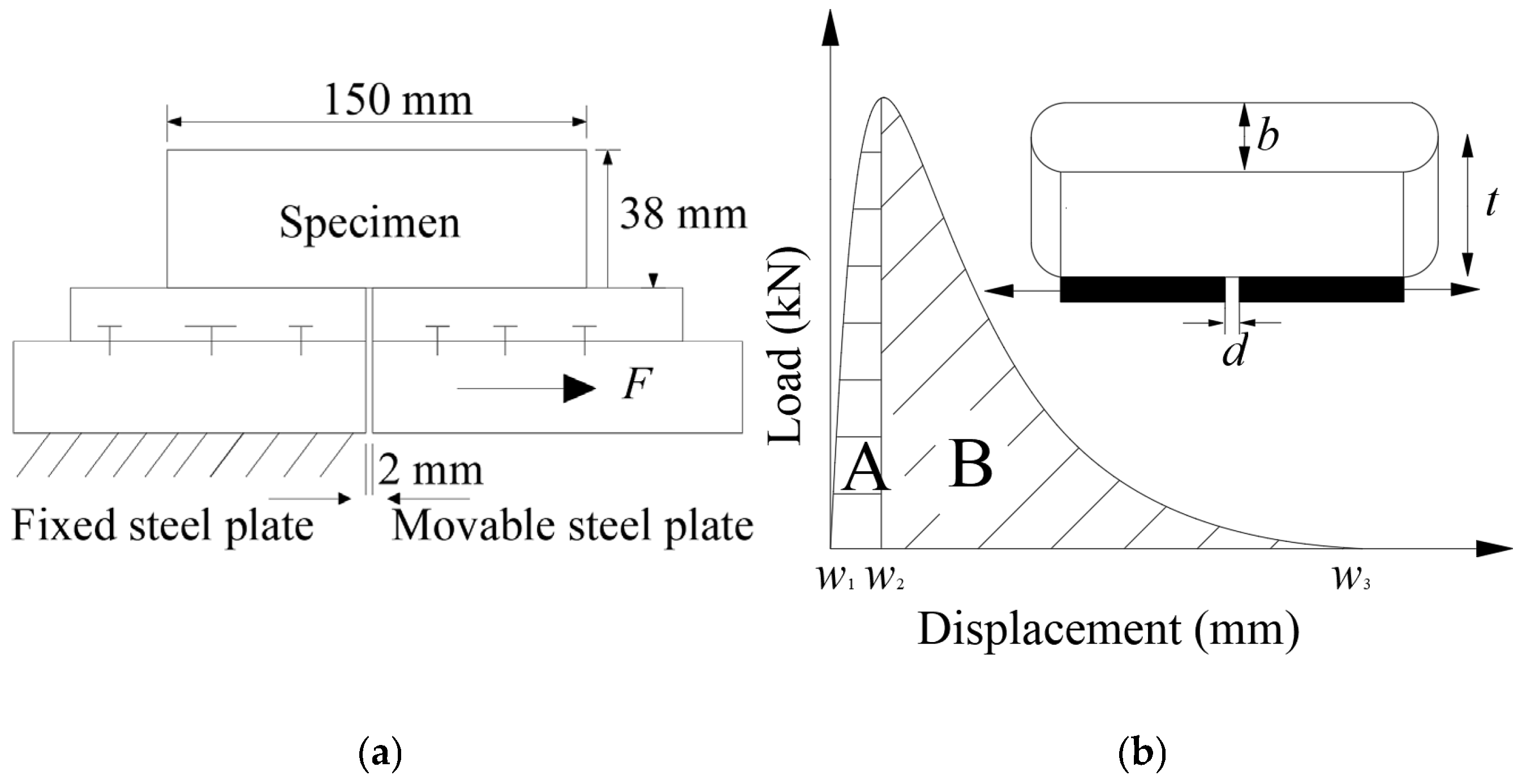
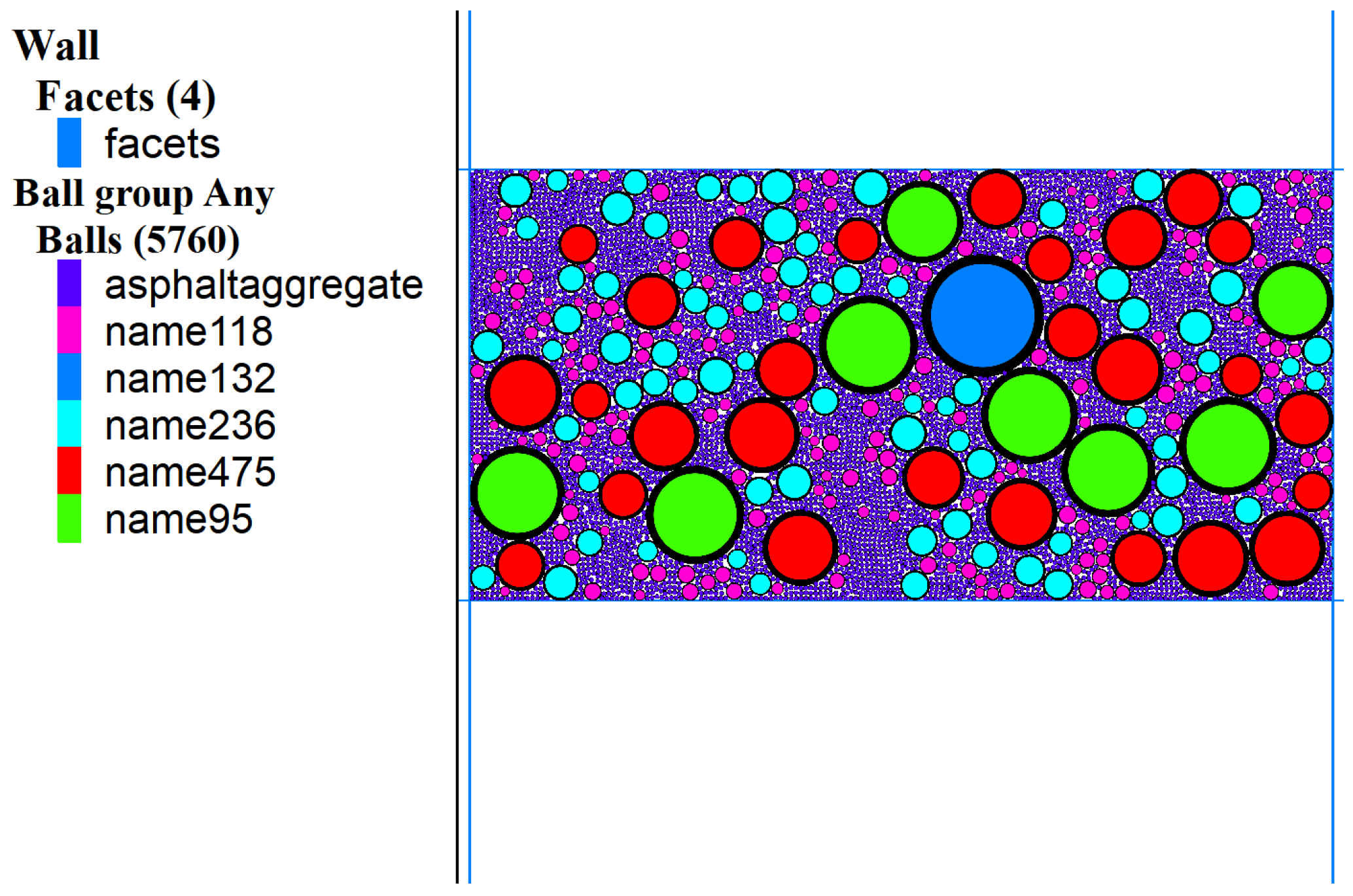
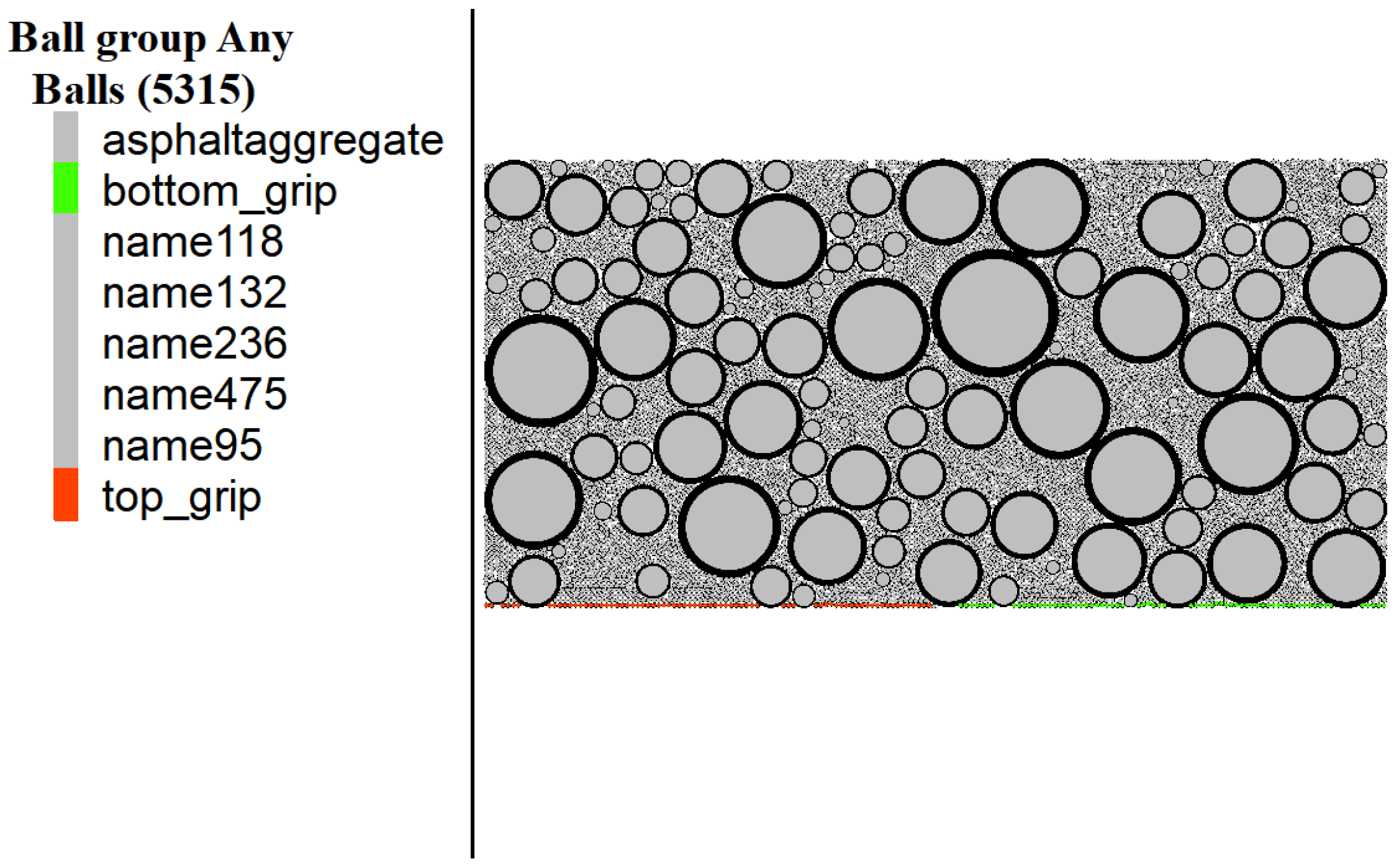

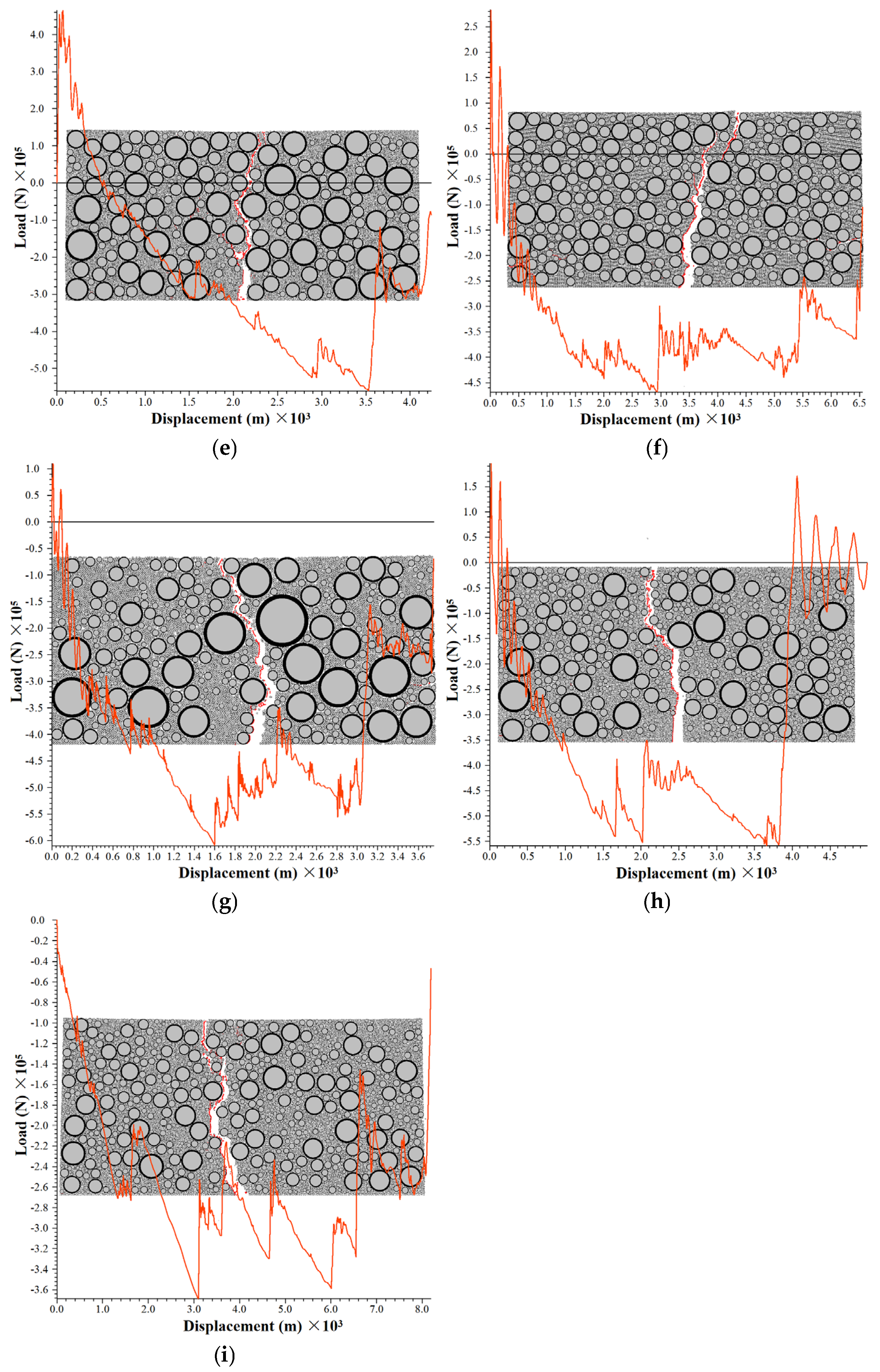
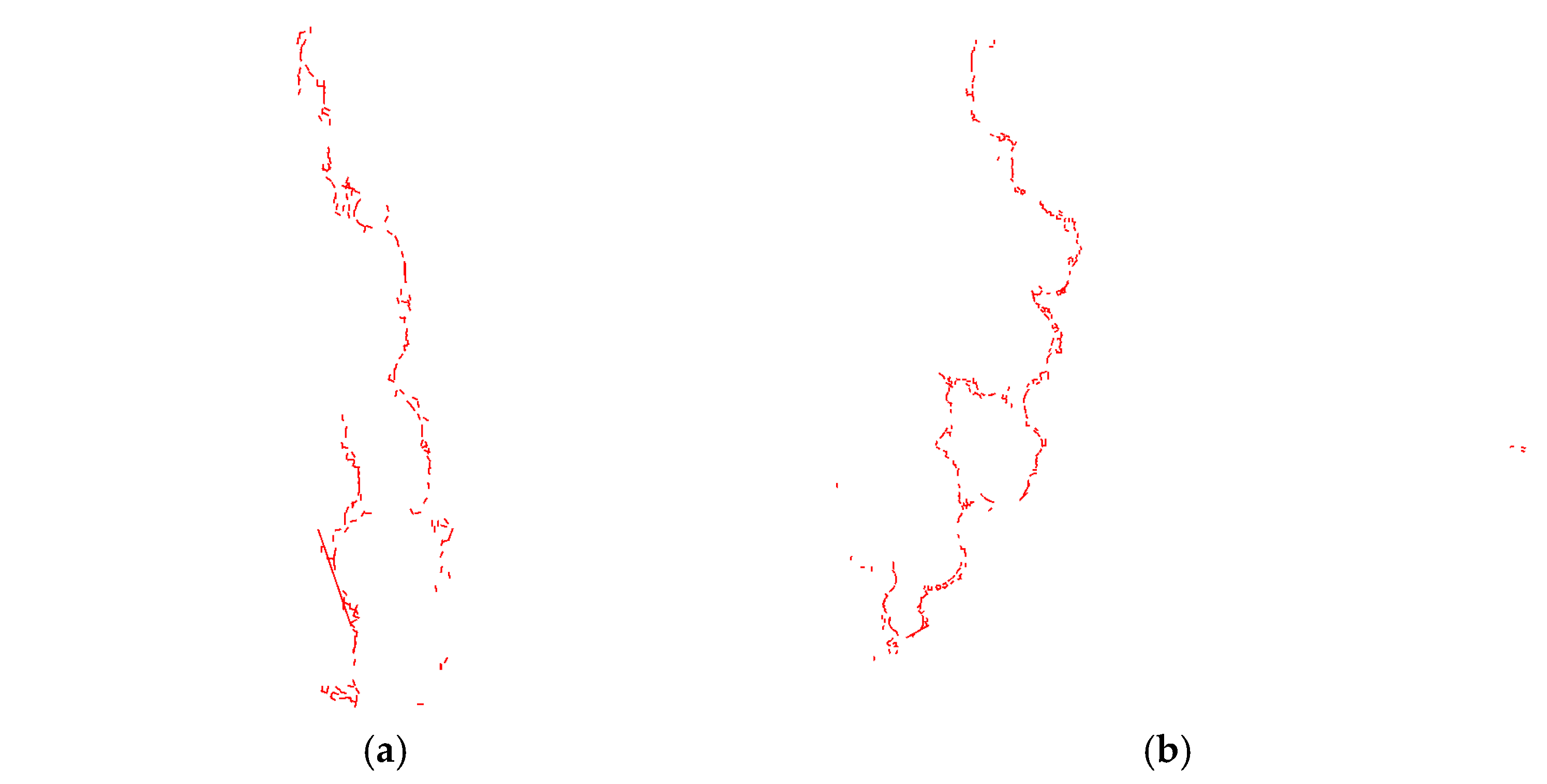
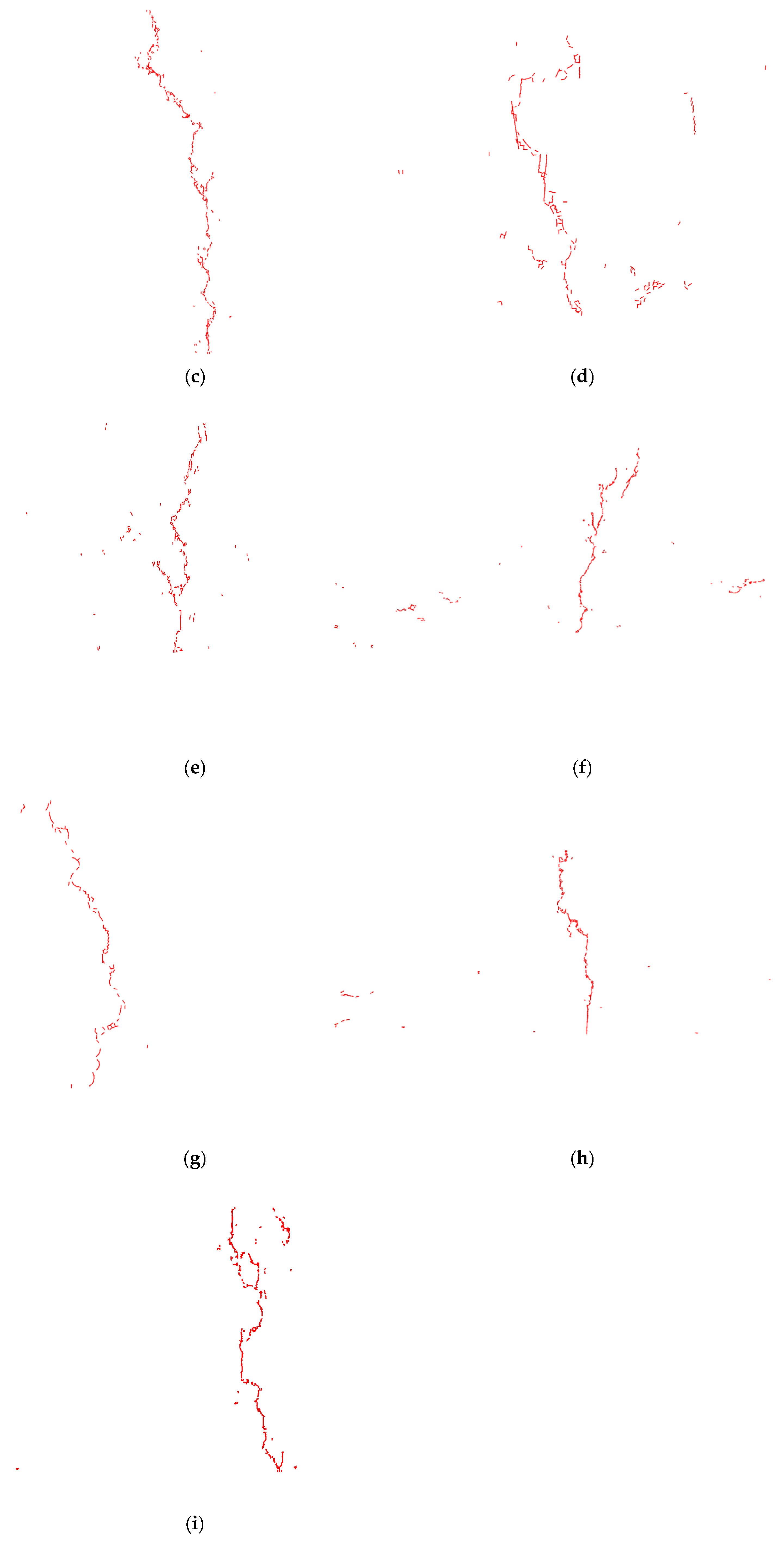


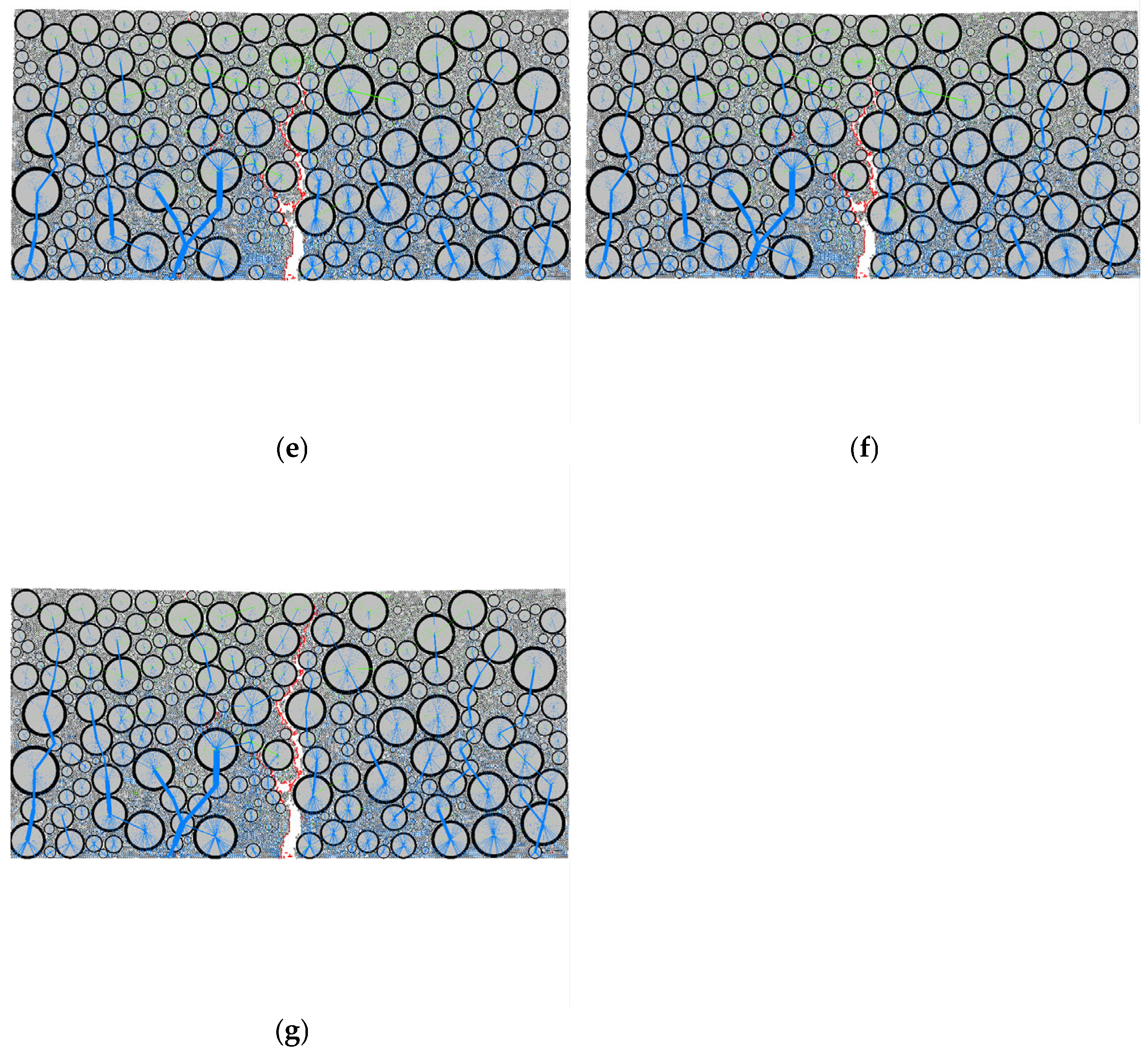
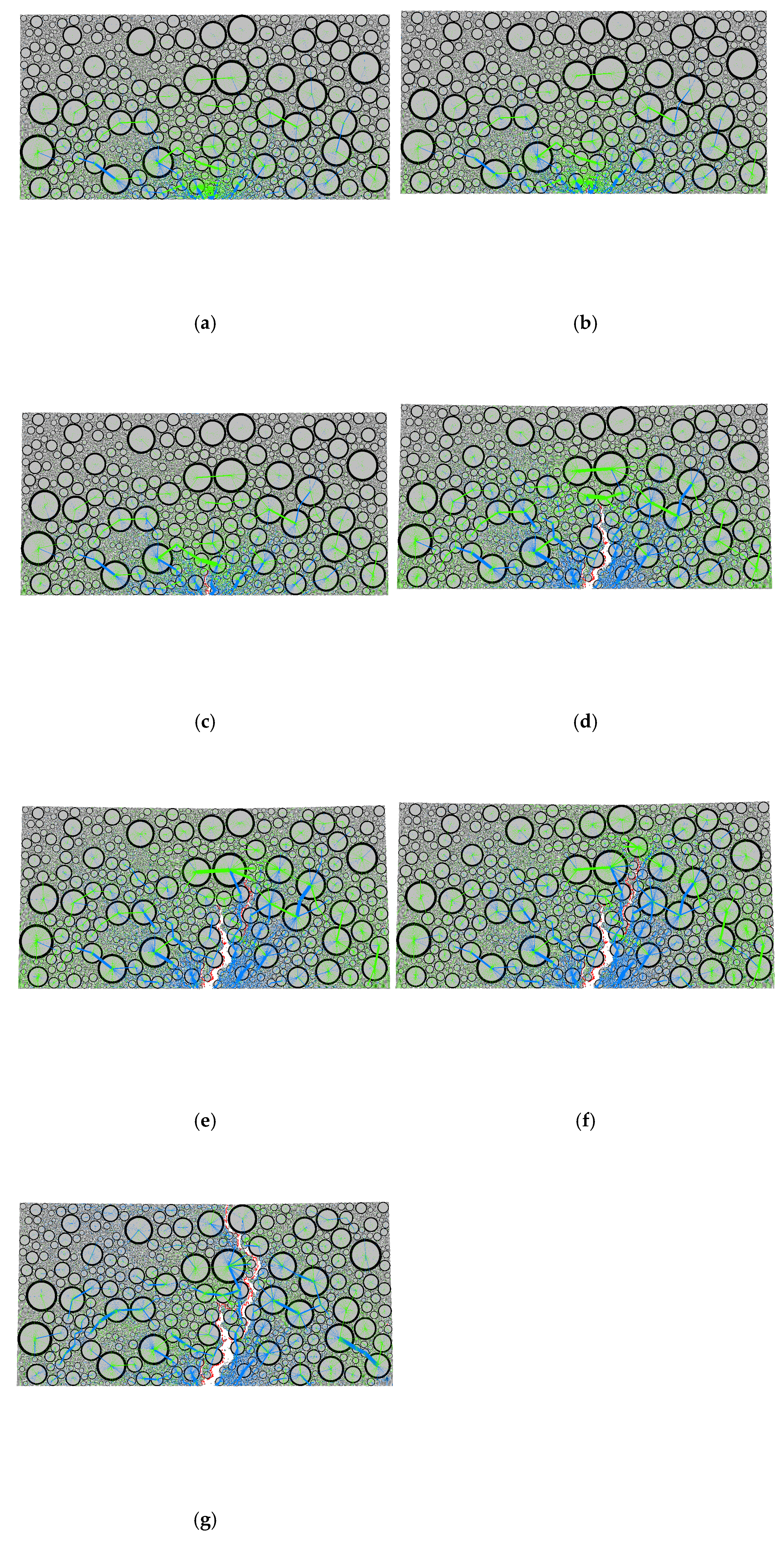
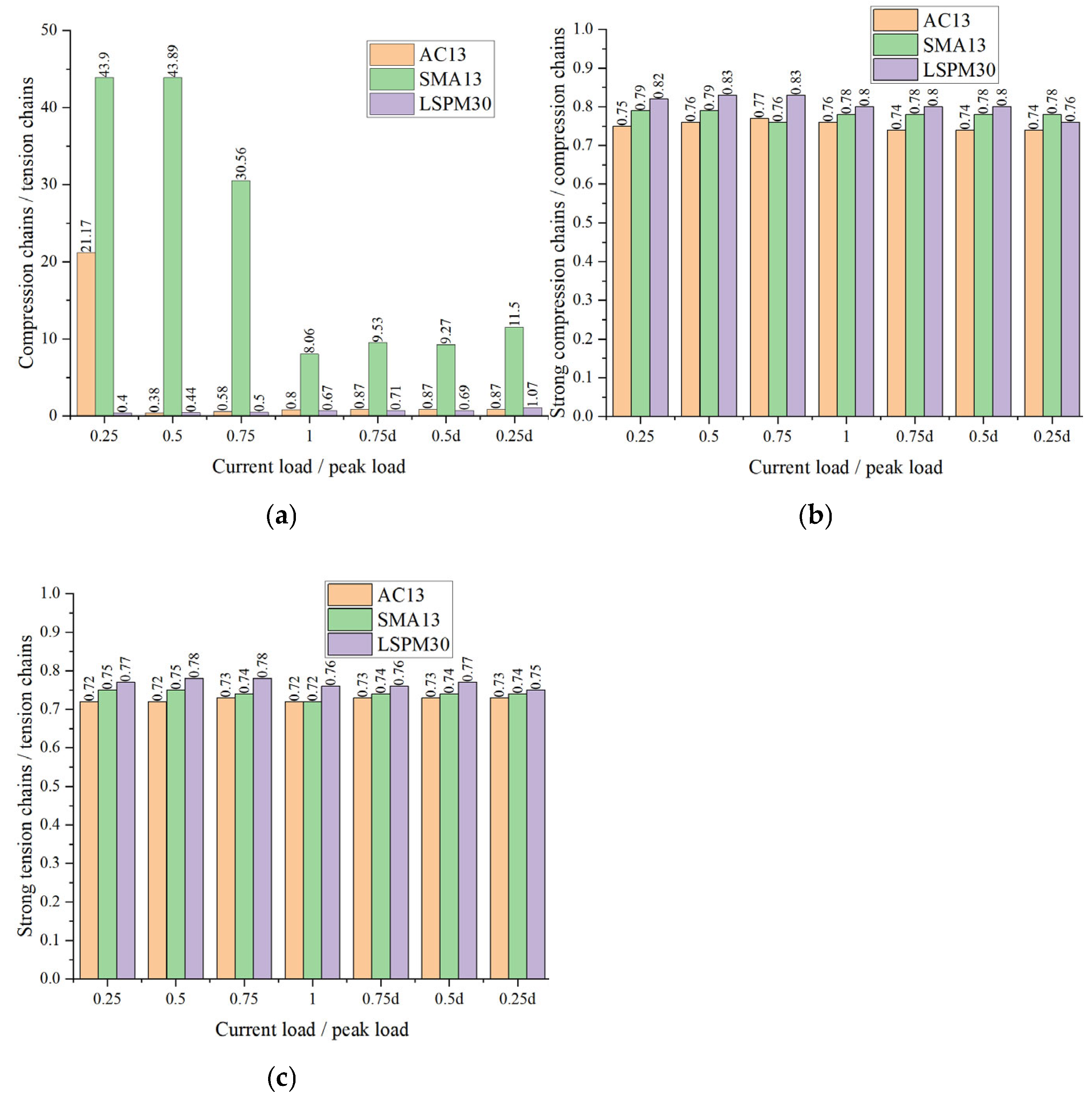

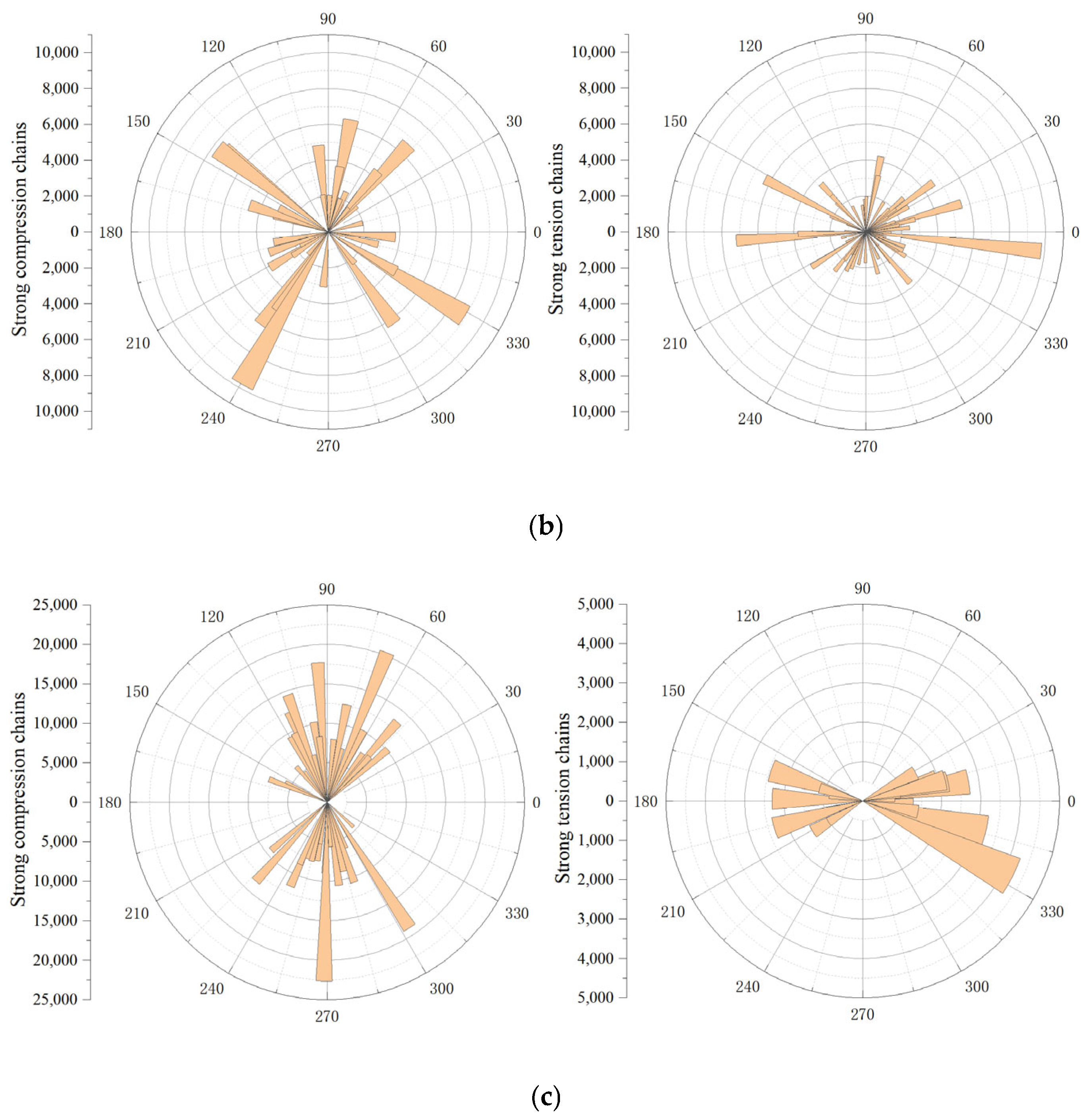

| Sieve Size (mm) | 37.5 | 31.5 | 26.5 | 19 | 16 | 13.2 | 9.5 | 4.75 | 2.36 | 1.18 | 0.6 | 0.3 | 0.15 | 0.075 |
|---|---|---|---|---|---|---|---|---|---|---|---|---|---|---|
| AC13 | 100 | 95 | 76.5 | 53 | 37 | 26.5 | 19 | 13.5 | 10 | 6 | ||||
| SMA13 | 100 | 95 | 62.5 | 27 | 20.5 | 19 | 16 | 13 | 12 | 10 | ||||
| LSPM30 | 100 | 94 | 76 | 60 | 52 | 43 | 30 | 15 | 11 | 8 | 6 | 3.7 | 2.9 | 2.5 |
| AC13 | SMA13 | LSPM30 | |
|---|---|---|---|
| Bitumen/aggregate ratio/% | 5.2 | 6.9 | 3.2 |
| Porosity/% | 3 | 3 | 15.6 |
| Asphalt density/(g/cm3) | 1.03 | 1.03 | 1.03 |
| Aggregate density/(g/cm3) | 2.7 | 2.7 | 2.7 |
| Sieve Size/(mm) | 31.5–37.5 | 26.5–31.5 | 19–26.5 | 16–19 | 13.2–16 | 9.5–13.2 | 4.75–9.5 | 2.36–4.75 | 1.18–2.36 |
|---|---|---|---|---|---|---|---|---|---|
| AC13 | 4.3% | 15.8% | 20.1% | 13.7 | 9.0% | ||||
| SMA13 | 4.1% | 26.7% | 29.1% | 5.3% | 1.2% | ||||
| LSPM30 | 4.7% | 14.0% | 12.5% | 6.2% | 7.0% | 10.1% | 11.7% | 3.1% |
| Property | Aggregate | Asphalt Mortar | Aggregate -Asphalt Mortar | Aggregate -Aggregate | Asphalt Mortar-Asphalt Mortar |
|---|---|---|---|---|---|
| Effective modulus (Pa) | 5.5 × 109 | 1.0 × 108 | - | - | - |
| Normal-to-shear stiffness ratio k | 1.5 | 1.5 | - | - | - |
| Bond effective modulus (Pa) | - | - | 2.0× 107 | 2.0× 107 | 2.0× 107 |
| Bond normal-to-shear stiffness ratio k* | - | - | 1.5 | 1.5 | 1.5 |
| Tensile strength (Pa) | - | - | 1.6 × 106 | 1.6 × 106 | 1.6 × 106 |
| Cohesion (Pa) | - | - | 3.2 × 106 | 3.2 × 106 | 3.2 × 106 |
| Friction coefficient | 0.7 | 0.5 | 0.5 | 0.5 | 0.5 |
| Specimens | Fractal Dimensions | Specimens | Fractal Dimensions | Specimens | Fractal Dimensions |
|---|---|---|---|---|---|
| AC13 52 mm × 104 mm | 0.996 | AC13 78 mm × 156 mm | 0.958 | AC13 104 mm × 208 mm | 1.052 |
| SMA13 52 mm × 104 mm | 1.044 | SMA13 78 mm × 156 mm | 0.924 | SMA13 104 mm × 208 mm | 0.970 |
| LSPM30 120 mm × 240 mm | 1.125 | LSPM30 180 mm × 360 mm | 1.082 | LSPM30 240 mm × 480 mm | 1.078 |
| Specimens | Fracture Energy | Specimens | Fracture Energy | Specimens | Fracture Energy |
|---|---|---|---|---|---|
| AC13 52 mm × 104 mm | 24.91 | AC13 78 mm × 156 mm | 19.52 | AC13 104 mm × 208 mm | 20.06 |
| SMA13 52 mm × 104 mm | 31.20 | SMA13 78 mm × 156 mm | 13.70 | SMA13 104 mm × 208 mm | 21.52 |
| LSPM30 120 mm × 240 mm | 22.29 | LSPM30 180 mm × 360 mm | 19.85 | LSPM30 240 mm × 480 mm | 17.52 |
| Total Quantity of Tensile Chains | Total Quantity of Compression Chains | Total Quantity of Strong Tensile Chains | Total Quantity of Strong Compression Chains | Strong Tension Chains/Tension Chains | Strong Compression Chains/Compression Chains | |
|---|---|---|---|---|---|---|
| 25% | 203 | 89 | 63 | 23 | 0.3103 | 0.2584 |
| 50% | 209 | 83 | 64 | 21 | 0.3062 | 0.2530 |
| 75% | 210 | 82 | 62 | 26 | 0.2952 | 0.3171 |
| 100% | 190 | 102 | 56 | 36 | 0.2947 | 0.3529 |
| 75d% | 181 | 112 | 67 | 35 | 0.3702 | 0.3125 |
| 50d% | 160 | 129 | 55 | 47 | 0.3438 | 0.3643 |
| 25d% | 101 | 186 | 39 | 60 | 0.3861 | 0.3226 |
| Total Quantity of Tensile Chains | Total Quantity of Compression Chains | Total Quantity of Strong Tensile Chains | Total Quantity of Strong Compression Chains | Strong Tension Chains/Tension Chains | Strong Compression Chains/Compression Chains | |
|---|---|---|---|---|---|---|
| 25% | 40 | 139 | 16 | 39 | 0.4000 | 0.2806 |
| 50% | 48 | 132 | 19 | 41 | 0.3958 | 0.3106 |
| 75% | 57 | 127 | 19 | 43 | 0.3333 | 0.3386 |
| 100% | 62 | 121 | 22 | 43 | 0.3548 | 0.3554 |
| 75d% | 45 | 139 | 17 | 44 | 0.3778 | 0.3165 |
| 50d% | 44 | 140 | 16 | 44 | 0.3636 | 0.3143 |
| 25d% | 33 | 152 | 15 | 45 | 0.4545 | 0.2961 |
| Total Quantity of Tensile Chains | Total Quantity of Compression Chains | Total Quantity of Strong Tensile Chains | Total Quantity of Strong Compression Chains | Strong Tension Chains/Tension Chains | Strong Compression Chains/Compression Chains | |
|---|---|---|---|---|---|---|
| 25% | 117 | 322 | 47 | 105 | 0.4017 | 0.3261 |
| 50% | 257 | 182 | 94 | 49 | 0.3658 | 0.2692 |
| 75% | 271 | 168 | 107 | 47 | 0.3948 | 0.2798 |
| 100% | 266 | 172 | 100 | 55 | 0.3759 | 0.3198 |
| 75d% | 150 | 285 | 49 | 90 | 0.3267 | 0.3158 |
| 50d% | 150 | 285 | 48 | 91 | 0.3200 | 0.3193 |
| 25d% | 151 | 284 | 48 | 92 | 0.3179 | 0.3239 |
| Total Quantity of Tensile Force Chains | Total Quantity of Compression Force Chains | Total Quantity of Strong Tensile Force Chains | Total Quantity of Weak Tensile Force Chains | Total Quantity of Compression Force Chains | Total Quantity of Weak Force Chains | Strong Tension Chains/Tension Chains | Weak Tension Chains/Tension Chains | Strong Compression Chains/Compress-Ion Chains | Weak Compression Chains/Compress-Ion Chains | |
|---|---|---|---|---|---|---|---|---|---|---|
| AC13 | 266 | 172 | 100 | 166 | 55 | 117 | 0.3759 | 0.6241 | 0.3198 | 0.6802 |
| SMA13 | 62 | 121 | 22 | 40 | 43 | 78 | 0.3548 | 0.6452 | 0.3554 | 0.6446 |
| LSPM30 | 190 | 102 | 56 | 134 | 36 | 66 | 0.2947 | 0.7053 | 0.3529 | 0.6471 |
| Total Number of Aggregates | Overall Displacement (×103) | Group 13.2 | Group 9.5 | Group 4.75 | Group 2.36 | Group 1.18 | Overall Average Displacement | |
|---|---|---|---|---|---|---|---|---|
| 25% | 694 | 0.2079 | 0.3342 | 0.2645 | 0.3004 | 0.3079 | 0.2976 | 0.2996 |
| 50% | 694 | 0.9270 | 1.4173 | 1.1809 | 1.3274 | 1.3723 | 1.3292 | 1.3358 |
| 75% | 694 | 0.9919 | 1.4827 | 1.2763 | 1.4310 | 1.4636 | 1.4221 | 1.4292 |
| 100% | 694 | 1.6414 | 2.3599 | 2.2569 | 2.4021 | 2.3803 | 2.3590 | 2.3652 |
| 75d% | 694 | 1.8275 | 2.8239 | 2.6115 | 2.5698 | 2.6457 | 2.6369 | 2.6332 |
| 50d% | 694 | 1.8275 | 2.8239 | 2.6115 | 2.5698 | 2.6457 | 2.6370 | 2.6333 |
| 25d% | 694 | 1.8275 | 2.8240 | 2.6116 | 2.5698 | 2.6458 | 2.6370 | 2.6333 |
| Group 13.2 | Group 9.5 | Group 4.75 | Group 2.36 | Group 1.18 | |
|---|---|---|---|---|---|
| 25% | 0.48 | 2.42 | 8.81 | 24.88 | 63.41 |
| 50% | 0.46 | 2.42 | 8.73 | 24.87 | 63.52 |
| 75% | 0.45 | 2.44 | 8.80 | 24.79 | 63.52 |
| 100% | 0.43 | 2.61 | 8.93 | 24.36 | 63.67 |
| 75d% | 0.46 | 2.72 | 8.58 | 24.32 | 63.92 |
| 50d% | 0.46 | 2.72 | 8.58 | 24.32 | 63.92 |
| 25d% | 0.46 | 2.72 | 8.58 | 24.32 | 63.92 |
| Total Number of Aggregates | Overall Displacement (×103) | Group 13.2 | Group 9.5 | Group 4.75 | Group 2.36 | Group 1.18 | Overall Average Displacement | |
|---|---|---|---|---|---|---|---|---|
| 25% | 251 | 0.1388 | 0.6236 | 0.6284 | 0.5270 | 0.5052 | 0.5996 | 0.5530 |
| 50% | 251 | 0.1859 | 0.7792 | 0.8445 | 0.7146 | 0.6665 | 0.8020 | 0.7405 |
| 75% | 251 | 0.3035 | 1.2071 | 1.3925 | 1.1856 | 1.0573 | 1.3112 | 1.2090 |
| 100% | 251 | 0.4264 | 1.7043 | 1.9721 | 1.6713 | 1.4645 | 1.8492 | 1.6989 |
| 75d% | 251 | 0.4815 | 2.0770 | 2.2770 | 1.8762 | 1.6236 | 2.1026 | 1.9183 |
| 50d% | 251 | 0.4873 | 2.1167 | 2.3084 | 1.8976 | 1.6416 | 2.1284 | 1.9414 |
| 25d% | 251 | 0.5063 | 2.3305 | 2.4279 | 1.9572 | 1.6929 | 2.2239 | 2.0170 |
| Group 13.2 | Group 9.5 | Group 4.75 | Group 2.36 | Group 1.18 | |
|---|---|---|---|---|---|
| 25% | 1.35 | 14.49 | 33.79 | 24.02 | 26.35 |
| 50% | 1.26 | 14.54 | 34.22 | 23.66 | 26.32 |
| 75% | 1.19 | 14.68 | 34.77 | 22.99 | 26.36 |
| 100% | 1.20 | 14.80 | 34.88 | 22.67 | 26.45 |
| 75d% | 1.29 | 15.13 | 34.68 | 22.26 | 26.64 |
| 50d% | 1.30 | 15.16 | 34.66 | 22.23 | 26.64 |
| 25d% | 1.38 | 15.35 | 34.41 | 22.07 | 26.80 |
| Total Number of Aggregates | Overall Displacement (×103) | Group 31.5 | Group 26 | Group 19 | Group 16 | Group 13.2 | Group 9.5 | Group 4.75 | Group 2.36 | Overall Average Displacement | |
|---|---|---|---|---|---|---|---|---|---|---|---|
| 25% | 539 | 0.2026 | 0.3312 | 0.3717 | 0.4011 | 0.3830 | 0.3632 | 0.3281 | 0.3843 | 0.3830 | 0.3759 |
| 50% | 539 | 0.3820 | 0.6075 | 0.6962 | 0.7694 | 0.7285 | 0.6881 | 0.6039 | 0.7281 | 0.7218 | 0.7088 |
| 75% | 539 | 0.8708 | 1.3837 | 1.5823 | 1.7494 | 1.6613 | 1.5513 | 1.3717 | 1.6643 | 1.6455 | 1.6157 |
| 100% | 539 | 2.4692 | 4.0184 | 4.5786 | 4.9143 | 4.6894 | 4.3635 | 3.7611 | 4.7483 | 4.6827 | 4.5811 |
| 75d% | 539 | 2.6668 | 4.2875 | 5.0331 | 5.3183 | 5.0824 | 4.7541 | 3.9496 | 5.1479 | 5.0619 | 4.9478 |
| 50d% | 539 | 2.6725 | 4.2482 | 5.0873 | 5.3451 | 5.1088 | 4.8168 | 3.8813 | 5.1692 | 5.0752 | 4.9582 |
| 25d% | 539 | 3.0584 | 4.7461 | 5.9729 | 6.2405 | 5.7366 | 5.7270 | 4.2148 | 5.9695 | 5.7903 | 5.6743 |
| Group 31.5 | Group 26 | Group 19 | Group 16 | Group 13.2 | Group 9.5 | Group 4.75 | Group 2.36 | |
|---|---|---|---|---|---|---|---|---|
| 25% | 0.49 | 2.57 | 3.96 | 3.21 | 4.84 | 10.53 | 36.03 | 38.37 |
| 50% | 0.48 | 2.55 | 4.03 | 3.24 | 4.86 | 10.27 | 36.21 | 38.35 |
| 75% | 0.48 | 2.54 | 4.02 | 3.24 | 4.81 | 10.24 | 36.31 | 38.36 |
| 100% | 0.49 | 2.60 | 3.98 | 3.23 | 4.77 | 9.90 | 36.54 | 38.50 |
| 75d% | 0.48 | 2.64 | 3.99 | 3.24 | 4.81 | 9.63 | 36.68 | 38.53 |
| 50d% | 0.48 | 2.67 | 4.00 | 3.25 | 4.87 | 9.44 | 36.75 | 38.55 |
| 25d% | 0.47 | 2.73 | 4.08 | 3.19 | 5.06 | 8.96 | 37.08 | 38.43 |
Disclaimer/Publisher’s Note: The statements, opinions and data contained in all publications are solely those of the individual author(s) and contributor(s) and not of MDPI and/or the editor(s). MDPI and/or the editor(s) disclaim responsibility for any injury to people or property resulting from any ideas, methods, instructions or products referred to in the content. |
© 2025 by the authors. Licensee MDPI, Basel, Switzerland. This article is an open access article distributed under the terms and conditions of the Creative Commons Attribution (CC BY) license (https://creativecommons.org/licenses/by/4.0/).
Share and Cite
Wei, J.; Fan, X.; Fu, T. Experimental Study on Overlay Tester of Asphalt Mixture Based on Discrete Element Method. Coatings 2025, 15, 1097. https://doi.org/10.3390/coatings15091097
Wei J, Fan X, Fu T. Experimental Study on Overlay Tester of Asphalt Mixture Based on Discrete Element Method. Coatings. 2025; 15(9):1097. https://doi.org/10.3390/coatings15091097
Chicago/Turabian StyleWei, Jianhui, Xiangyang Fan, and Tao Fu. 2025. "Experimental Study on Overlay Tester of Asphalt Mixture Based on Discrete Element Method" Coatings 15, no. 9: 1097. https://doi.org/10.3390/coatings15091097
APA StyleWei, J., Fan, X., & Fu, T. (2025). Experimental Study on Overlay Tester of Asphalt Mixture Based on Discrete Element Method. Coatings, 15(9), 1097. https://doi.org/10.3390/coatings15091097






